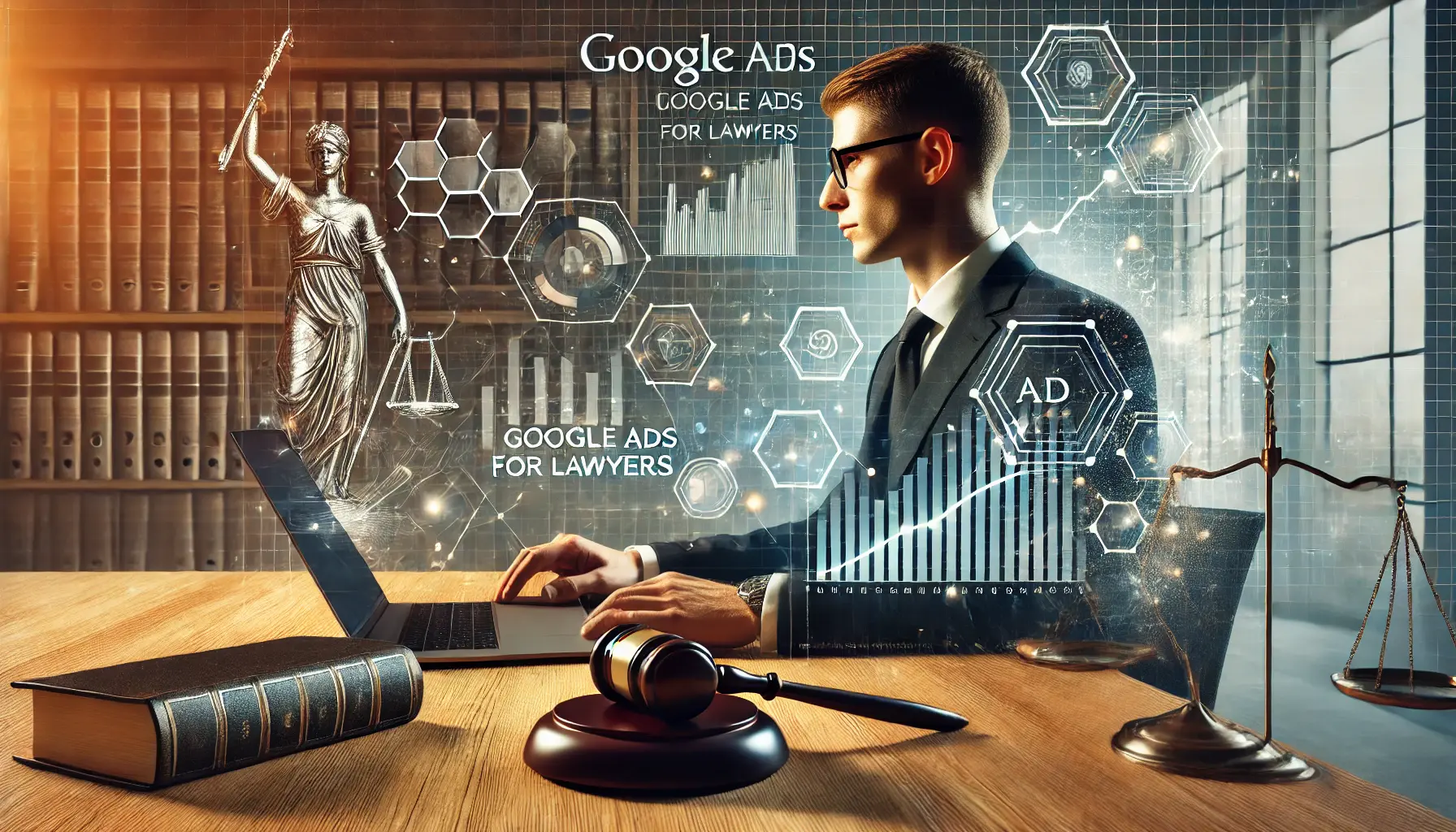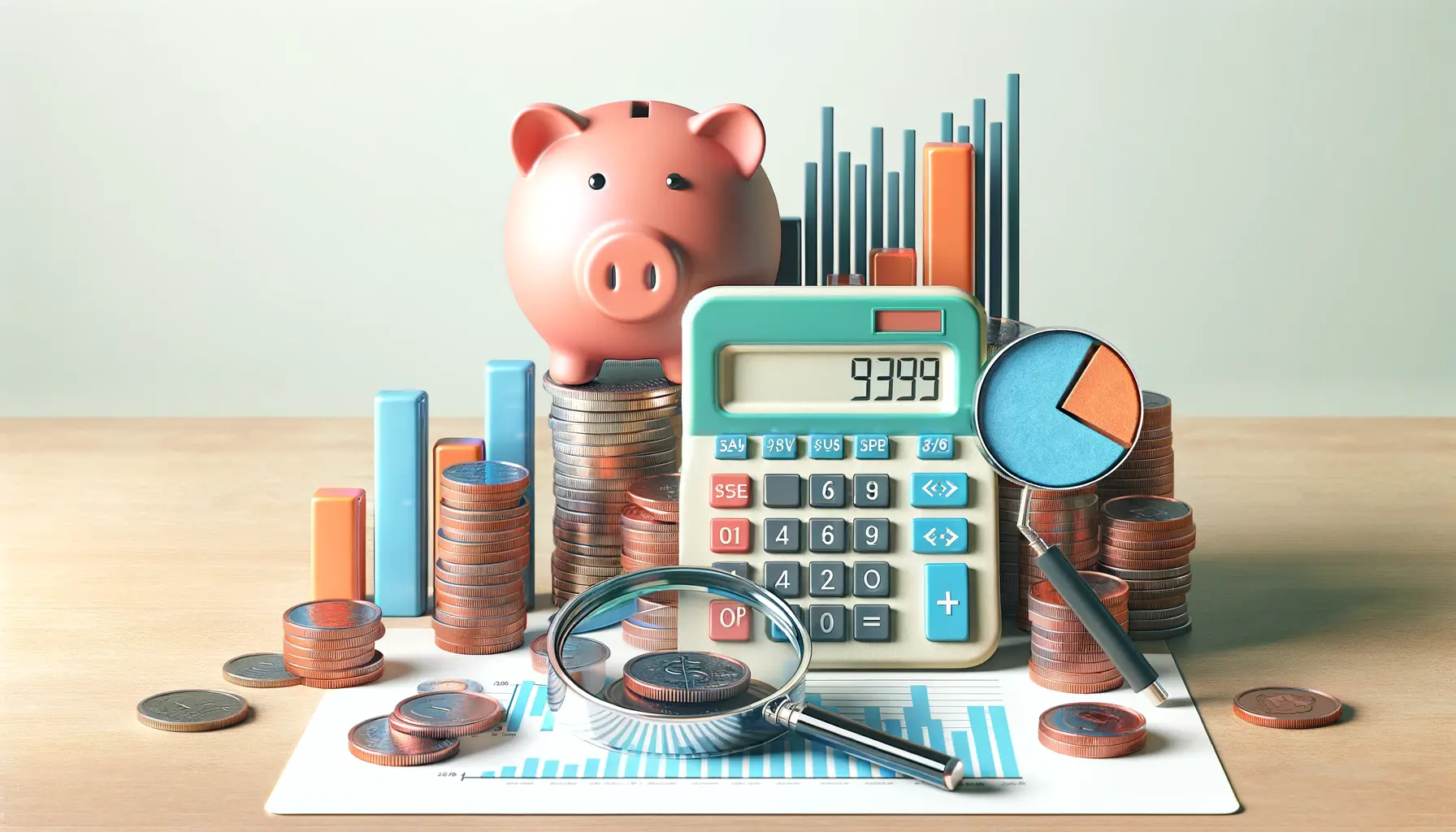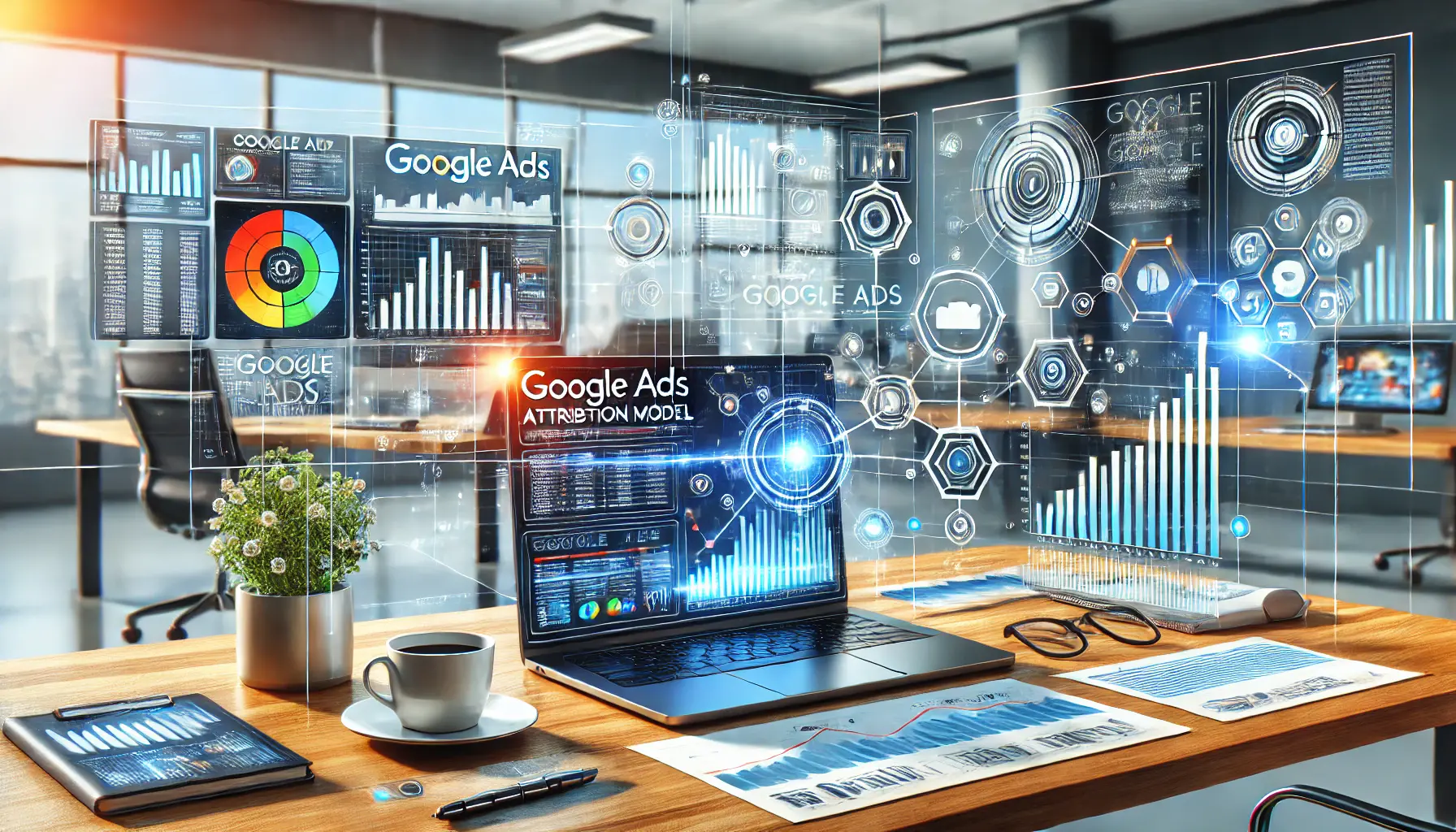In the ever-changing world of digital marketing, knowing the industry benchmarks in Google Ads is critical for any business to further optimize their advertising methods.
Understanding key metrics such as Click-Through Rate (CTR), Cost-Per-Click (CPC), Conversion RateThe percentage of ad clicks that result in a desired action, such as a purchase or sign-up., and Cost Per Lead (CPL) can provide valuable insights into your campaign’s performance compared to industry standards.
Let’s delve into these metrics to help you navigate the competitive world of Google Ads in 2024.
- Understanding Key Metrics in Google Ads
- Year-over-Year Changes in Google Ads Performance
- Latest Google Ads Features and Updates in 2024
- Strategies to Optimize Your Google Ads Campaigns in 2024
- Impact of Economic Factors on Google Ads Metrics in 2024
- Summary of 2024 Industry Benchmarks in Google Ads
- 2024 Industry Benchmarks in Google Ads: Frequently Asked Questions
Understanding Key Metrics in Google Ads
Grasping the fundamental metrics in Google Ads is essential for evaluating and enhancing your advertising efforts.
By familiarizing yourself with these key performance indicators, you can make informed decisions to improve your campaigns.

Insights into CTR trends across various industries, highlighting performance metrics.
Click-Through Rate (CTR) Trends Across Industries
CTR refers to the percentage of users who click on your ad after seeing it.
It is a metric showing how well your ad copy works and how relevant it is to the target audience.
In 2024, the average CTR across all industries is about 6.42%.
However, this varies by sector:
- Arts and Entertainment: 13.04%
- Sports and Recreation: 9.66%
- Real Estate: 9.20%
- Attorneys and Legal Services: 5.30%
- Home and Home Improvement: 5.59%
- Dentists and Dental Services: 5.38%
These figures highlight the importance of tailoring your ad content to your specific industry to achieve optimal engagement.

Analyzing CPC trends across various industries with sector-specific insights.
Cost-Per-Click (CPC) Variations by Sector
CPC represents the amount you pay each time someone clicks on your ad.
It’s influenced by factors such as industry competitiveness and keyword demand.
The average CPC in 2024 is around $4.22, with notable variations:
- Attorneys and Legal Services: $9.21
- Dentists and Dental Services: $6.69
- Home and Home Improvement: $6.55
- Arts and Entertainment: $3.13
- Real Estate: $1.55
- Travel: $1.63
Understanding these variations can help you set realistic budgets and bidding strategies aligned with your industry’s standards.

Examining conversion rate trends and benchmarks across industries in 2024.
Conversion Rate Benchmarks in 2024
The conversion rate is the percentage of ad clicks that result in a desired action, such as a purchase or sign-up.
The average conversion rate across industries in 2024 is about 7.04%.
Here are some industry-specific benchmarks:
- Automotive Repair: 12.96%
- Animals and Pets: 12.03%
- Physicians and Surgeons: 11.08%
- Furniture: 2.53%
- Finance and Insurance: 2.78%
- Real Estate: 2.91%
These benchmarks provide a reference to assess your campaign’s effectiveness in driving valuable customer actions.
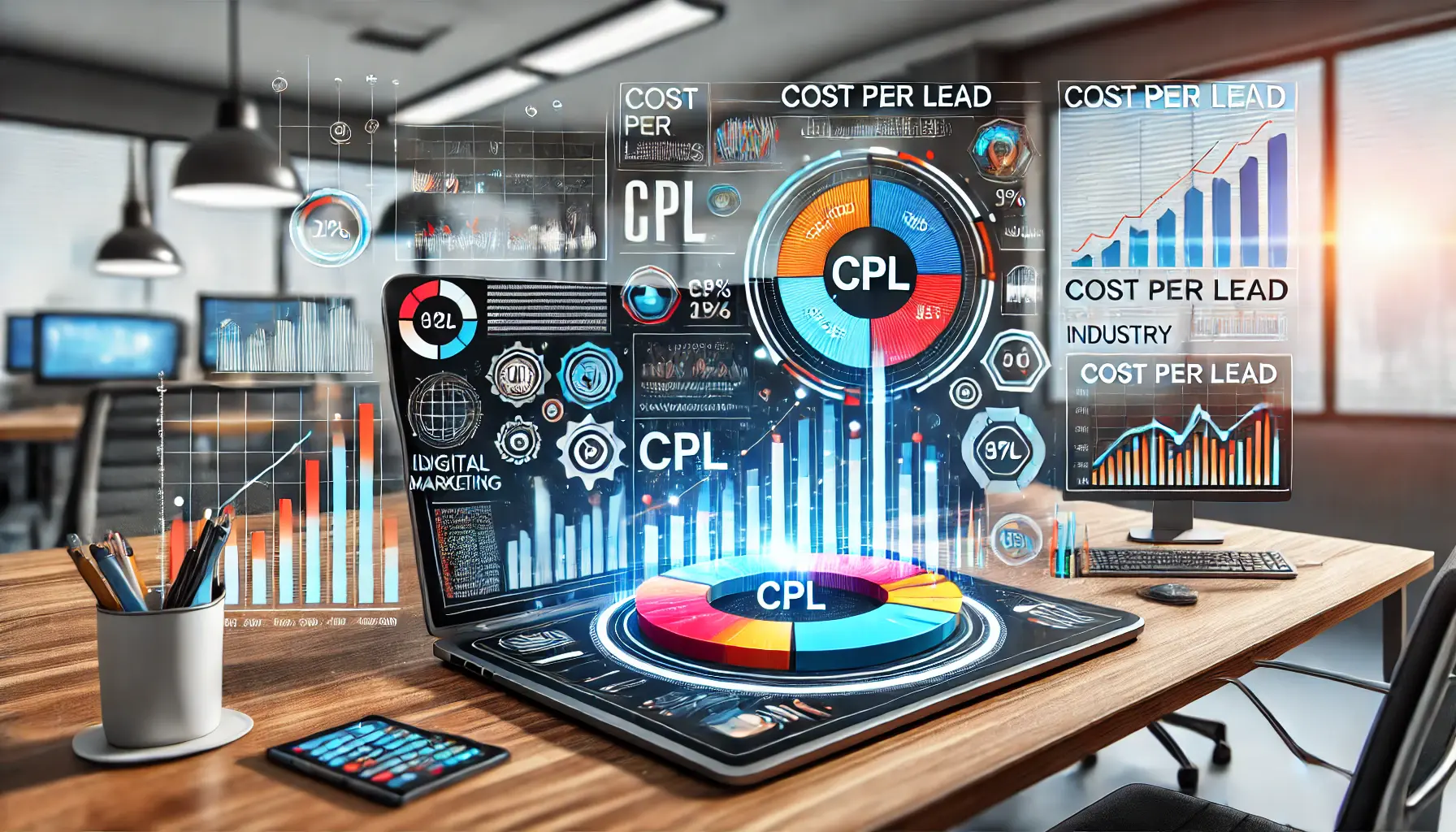
Analyzing Cost Per Lead (CPL) trends and insights across industries.
Cost Per Lead (CPL) Averages and Insights
CPL measures the average cost incurred to acquire a potential customer through your ads.
In 2024, the average CPL is about $53.52, with industry-specific insights as follows:
- Automotive Repair: $27.94
- Restaurants and Food: $29.67
- Animals and Pets: $34.81
- Career and Employment: $81.85
- Arts and Entertainment: $78.45
- Real Estate: $75.00
Monitoring your CPL lets you ensure that money spent on advertising yields affordable leads, enabling you to adjust your methods for an improved ROI.
These metrics will help benchmark your performance against industry standards, identify areas for improvement, and implement strategies that boost campaign effectiveness in 2024.
Knowing the critical metrics like CTR, CPC, Conversion Rate, and CPL helps businesses make informed decisions to optimize their Google Ads campaigns in 2024.

Year-over-year performance comparison in Google Ads, illustrating trends from 2023 to 2024.
Year-over-Year Changes in Google Ads Performance
Understanding how Google Ads metrics have evolved from 2023 to 2024 is essential for refining your advertising strategies.
By analyzing these year-over-year changes, you can identify trends and adjust your campaigns to maintain a competitive edge.

Tracking CTR improvements across industries, highlighting performance growth.
Industries with Significant CTR Improvements
Click-Through Rate (CTR) is a key indicator of ad engagement.
In 2024, 70% of industries saw an increase in CTR, with an overall average increase of 5% since 2023.
The following sectors realized remarkable improvements in CTR:
- Arts and Entertainment: Realized a CTR of 13.04%, indicating better audience engagement.
- Sports and Recreation: Attained a CTR of 9.66%, reflecting better ad targeting strategies.
- Real Estate: Achieved a CTR of 9.20%, showcasing successful ad relevance and appeal.
These increases suggest that ads in these industries have become more compelling and better aligned with user intent.

Tracking the increase in CPC across sectors with dynamic data visualizations.
Sectors Experiencing Rising CPC Costs
Cost-Per-Click (CPC) measures the average amount paid for each ad click.
In 2024, 86% of industries faced an increase in CPC, with an average overall rise of 10%.
Industries with notable CPC hikes include:
- Real Estate: CPC soared by more than 25% year-over-year as competition intensified.
- Sports and Recreation: CPC increased by a growth rate of over 25%, reflecting strong and growing advertiser demand.
- Personal Services: CPC jumped upwards by more than 25%, suggesting increasing demand in the ad space.
These trends underscore the need for efficient budget management and strategic bidding to maintain cost-effectiveness.

Analyzing conversion rate trends with increases and decreases across industries using data visualizations.
Conversion Rate Increases and Decreases by Industry
Conversion Rate (CVR) is the percentage of ad clicks resulting in desired actions.
In 2024, 12 out of 23 industries experienced a decrease in their CVR by an average of 1%.
However, some sectors achieved significant improvements:
- Apparel / Fashion and Jewelry: Recorded a remarkable 112.01% increase in CVR, reflecting successful optimization efforts.
- Career and Employment: Achieved an 80.97% rise in CVR, indicating effective campaign strategies.
Conversely, industries such as Finance & Insurance and Dentists & Dental Services experienced notable declines in CVR, underscoring the need for continuous optimization.

Tracking CPL trends and variations across different industries with data visualizations.
Trends in Cost Per Lead Across Different Sectors
Cost Per Lead (CPL) refers to the average cost of acquiring a potential customer.
In 2024, 19 out of 23 industries experienced increased CPL, with an average rise of approximately 25%.
This is slightly lower than the previous year’s increase of 27%, indicating that economic challenges continue to affect advertising costs.
Tracking changes in CPL is essential to gauge the effectiveness of your lead generation efforts and ensure value-for-money returns on investment.
Understanding these year-over-year changes in Google Ads performance will help you make informed decisions to optimize your advertising strategies for improved results in 2024.
Significant changes in CTR, CPC, and CPL from 2023 to 2024 highlight the evolving competitive landscape in digital advertising.
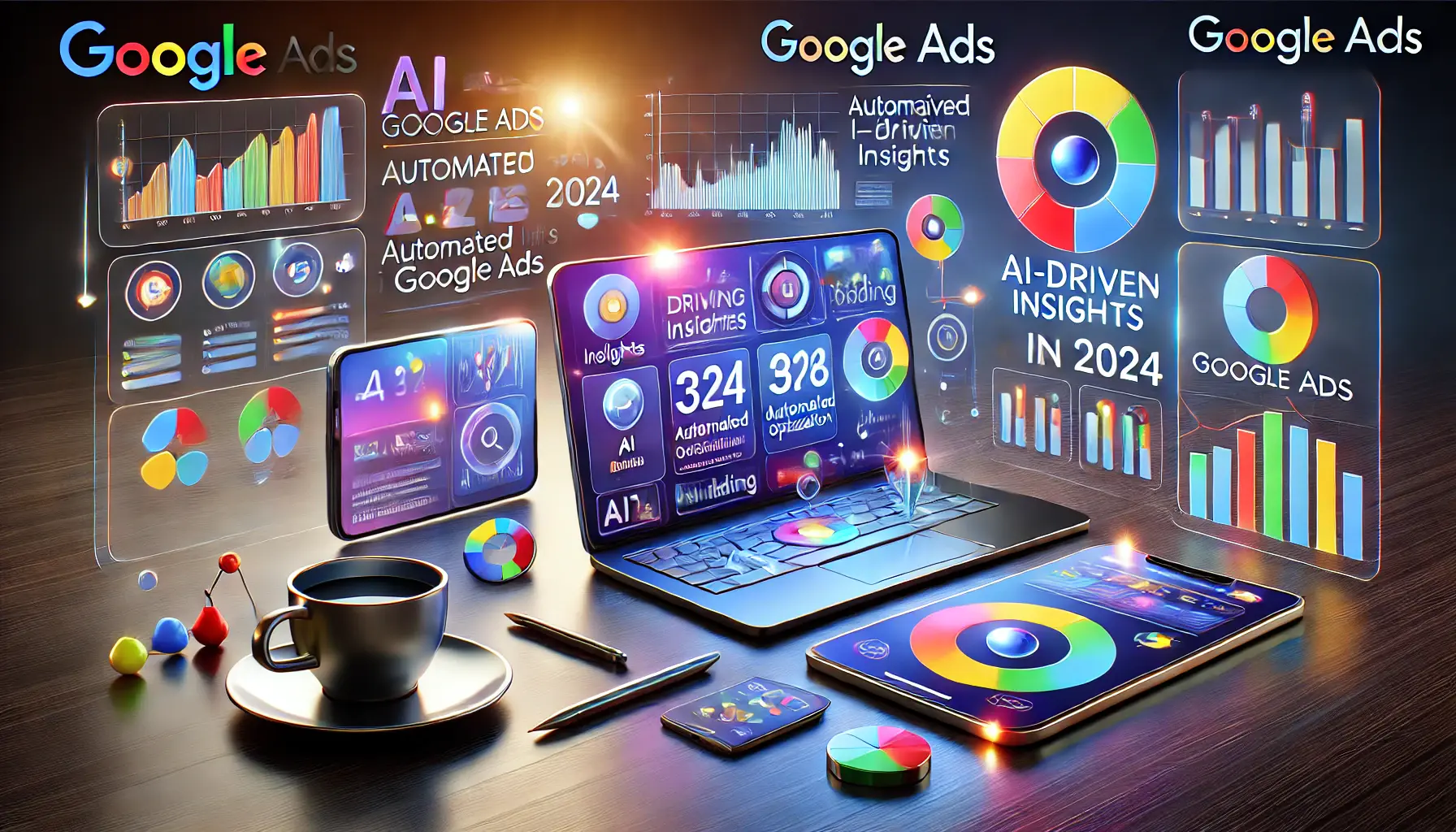
Exploring the latest features and updates in Google Ads for 2024, focusing on AI and campaign optimization.
Latest Google Ads Features and Updates in 2024
Staying updated with the latest features and updates in Google Ads is essential for maintaining a competitive edge in digital advertising.
In 2024, Google introduced several enhancements aimed at improving campaign performance and user engagement.

Exploring AI-powered campaigns and automation in digital marketing, with dynamic AI-driven insights and tools.
AI-Powered Campaigns and Automation
Google Ads has significantly expanded its AI capabilities, introducing features that streamline campaign management and enhance ad performance.
Key updates include:
- Conversational Experience for Campaign Creation: With the conversational interface, it’s simpler to set up campaigns from scratch, while receiving specific recommendations based on chosen goals. This feature leverages AI to further enhance the intuitive nature and efficiency of campaign creation.
- Enhanced Performance Max Campaigns: Performance Max campaigns now offer improved AI-driven asset creation, allowing advertisers to generate high-quality images and videos directly within the platform. This enhancement enables more dynamic and engaging ad creatives, contributing to better campaign outcomes.
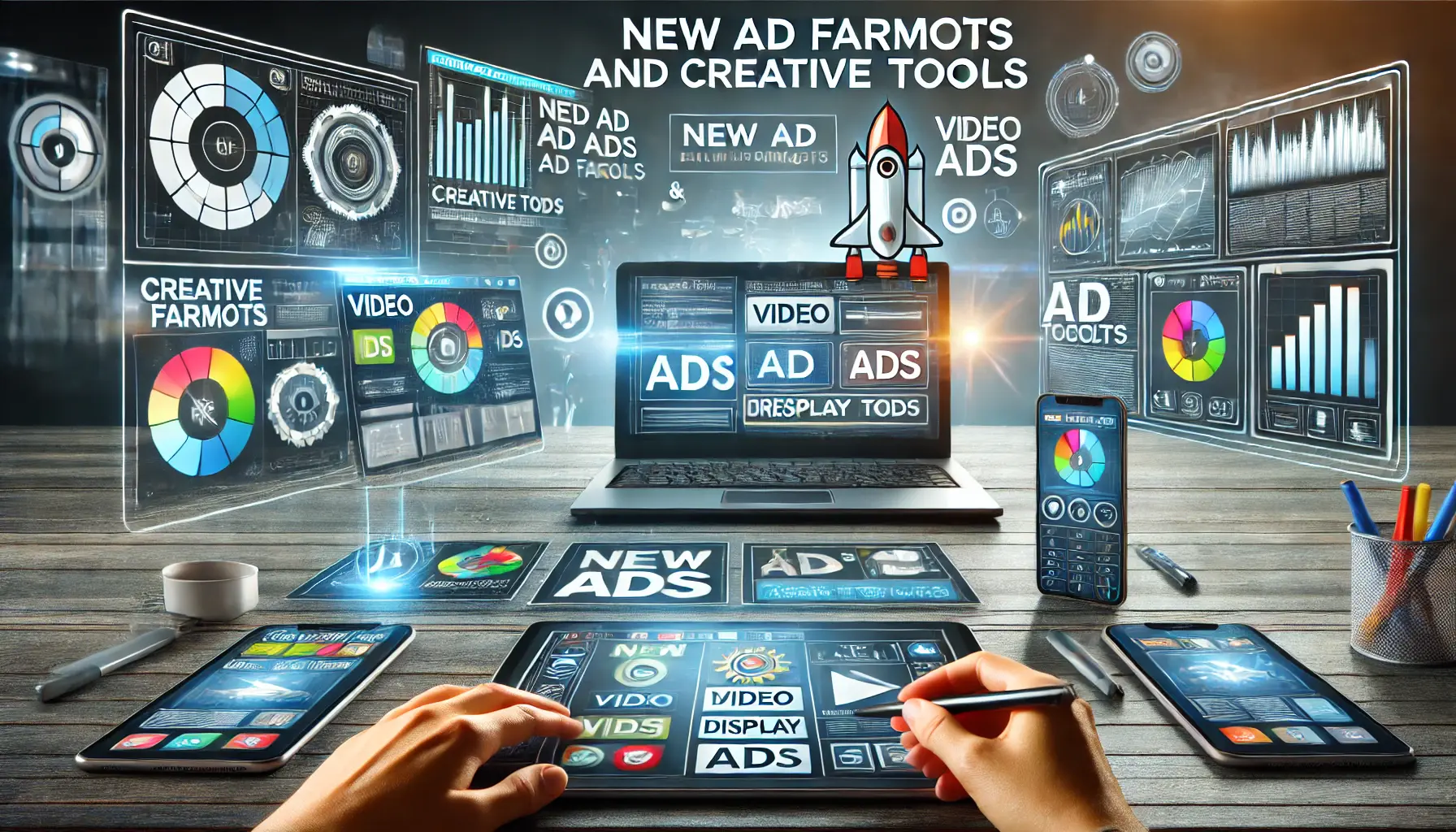
Exploring new ad formats and creative tools in digital marketing, with a focus on interactive and dynamic ad types.
New Ad Formats and Creative Tools
To help advertisers connect with audiences more effectively, Google has introduced new ad formats and creative tools:
- Demand Gen Campaigns: Designed to engage users on YouTube, Discover, and Gmail, Demand Gen campaigns harness AI to optimize ad placements and formats for better reach and engagement. This helps advertisers deliver personalized content at each touchpoint.
- AI-Generated Assets: Advertisers can now input text prompts to generate high-quality images for their ads, streamlining the creative process and reducing the need for extensive design resources. This tool leverages generative AI to produce visuals that align with brand aesthetics and campaign objectives.

Exploring improved measurement and reporting tools in digital marketing, with dynamic data analysis dashboards.
Improved Measurement and Reporting
Accurate measurement is crucial for assessing the effectiveness of campaigns.
To offer deeper insights into campaign success, Google has announced the release of the following new tools:
- Enhanced Conversion Tracking: Increased granularity in conversion tracking allows advertisers to better understand user interactions and optimize for desired outcomes. This improvement helps refine targeting strategies and measure return on investment.
- AI-Powered Insights: AI-driven insights are now available on the platform, identifying trends and opportunities in campaign data to help advertisers make informed decisions. These insights uncover patterns that may not be immediately apparent, facilitating proactive campaign adjustments.
By leveraging these new features and updates, advertisers can enhance their Google Ads campaigns, achieve better performance, and effectively reach their target audiences in 2024.
New AI-powered tools like enhanced Performance Max campaignsAn AI-driven campaign type in Google Ads that optimizes ad placement across multiple platforms. and Demand Gen campaigns redefine how advertisers create and manage campaigns effectively.
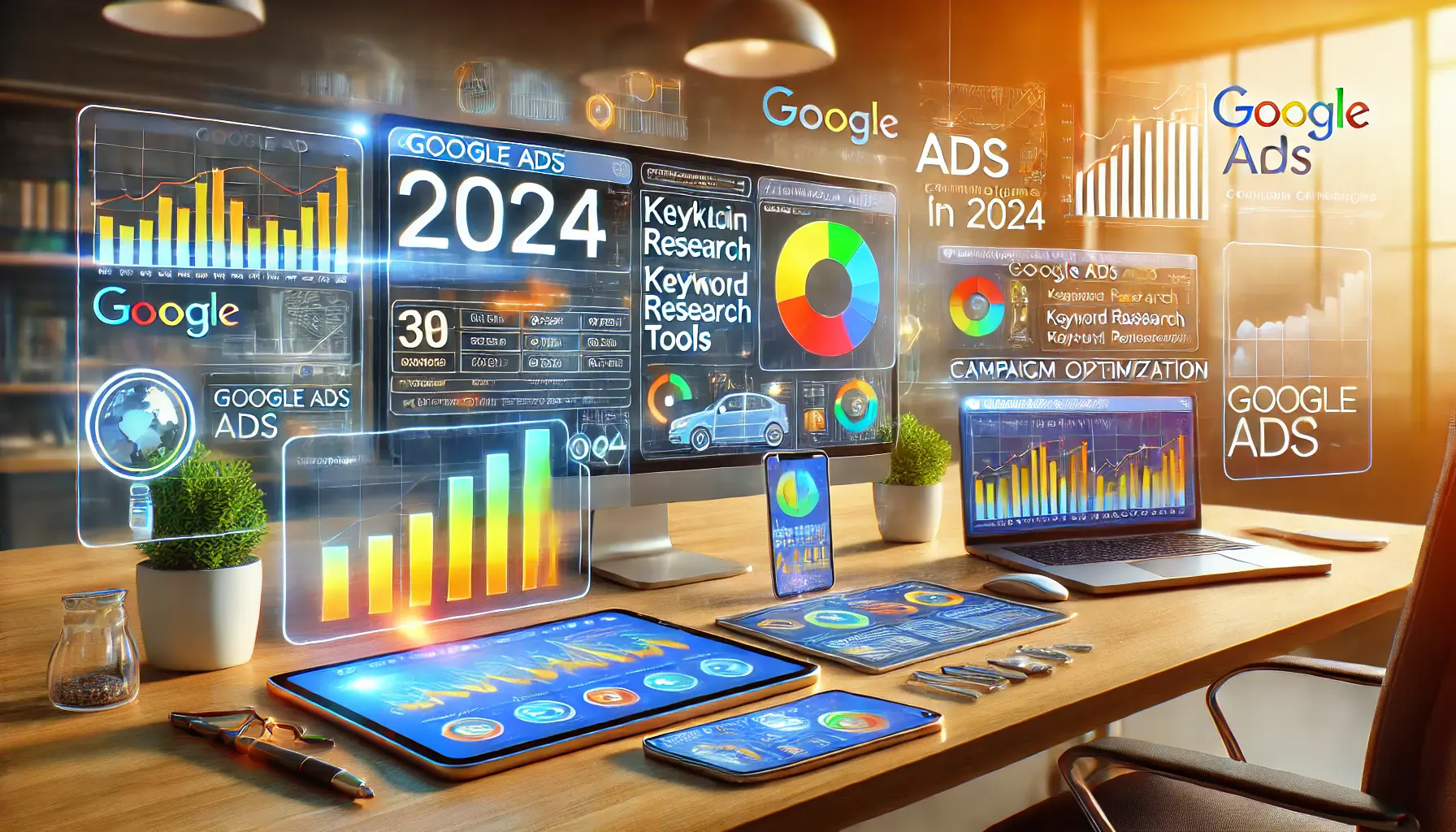
Exploring strategies to optimize Google Ads campaigns with real-time data analysis and campaign management tools.
Strategies to Optimize Your Google Ads Campaigns in 2024
In the dynamic world of digital marketing, optimizing your Google Ads campaigns is essential to maximize return on investment (ROI) and achieve your advertising goals.
Implementing effective strategies can significantly enhance your campaign performance in 2024.
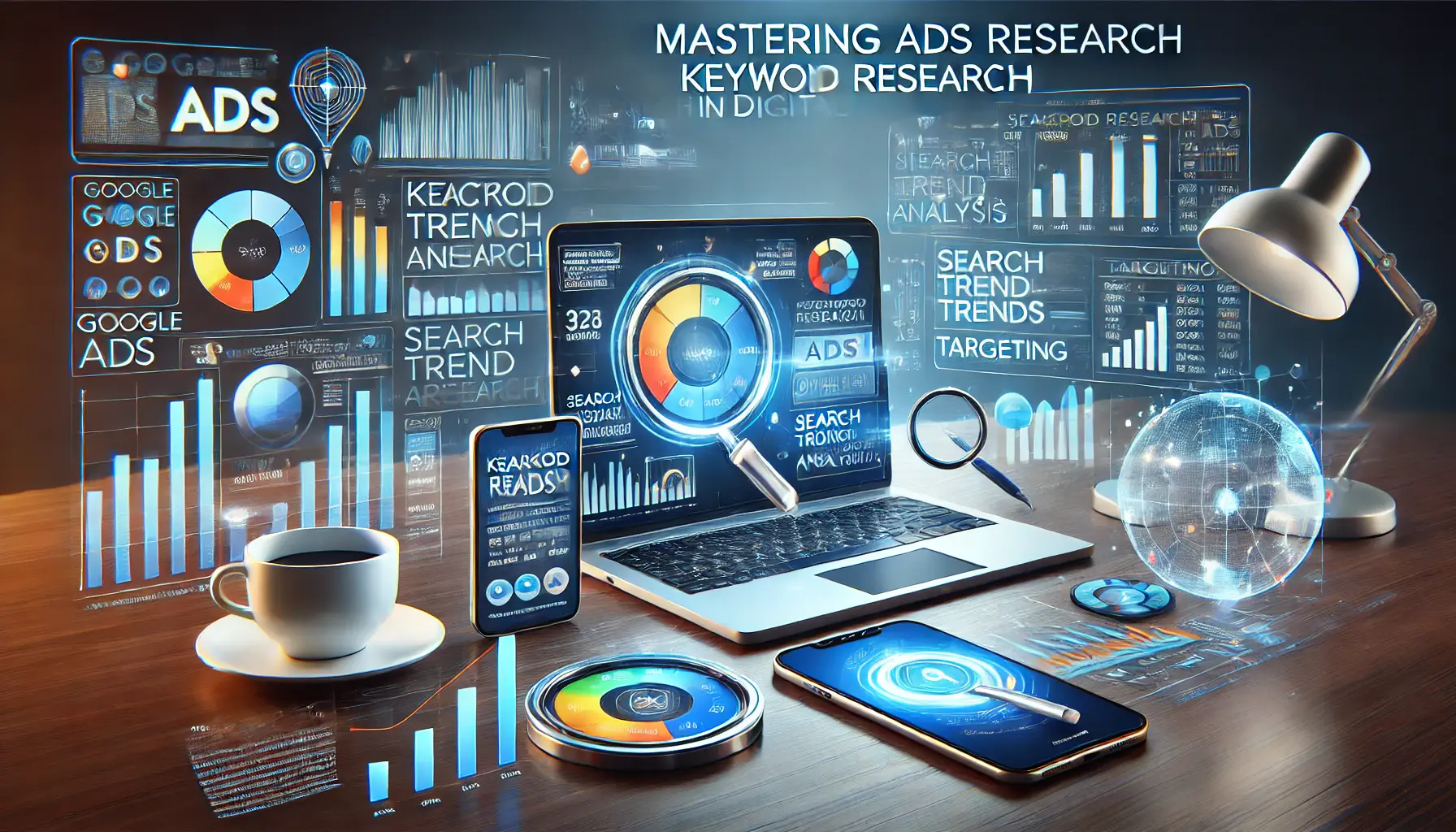
Optimizing Google Ads campaigns with advanced keyword research tools and search trend analysis.
Master Ads Keyword Research
Effective keyword research goes beyond selecting the right words.
Understanding the user’s intention and search patterns is crucial for your Google Ads’ success because it connects your ad offerings to the specific needs and behaviors of your target audience.
For instance, suppose you operate a store that sells life jackets.
By using very specific keywords like “life jackets” or “personal flotation devices,” you can directly cover the product offering.
However, delving deeper into user intent can uncover more targeted keywords that align with potential customers’ search behaviors.
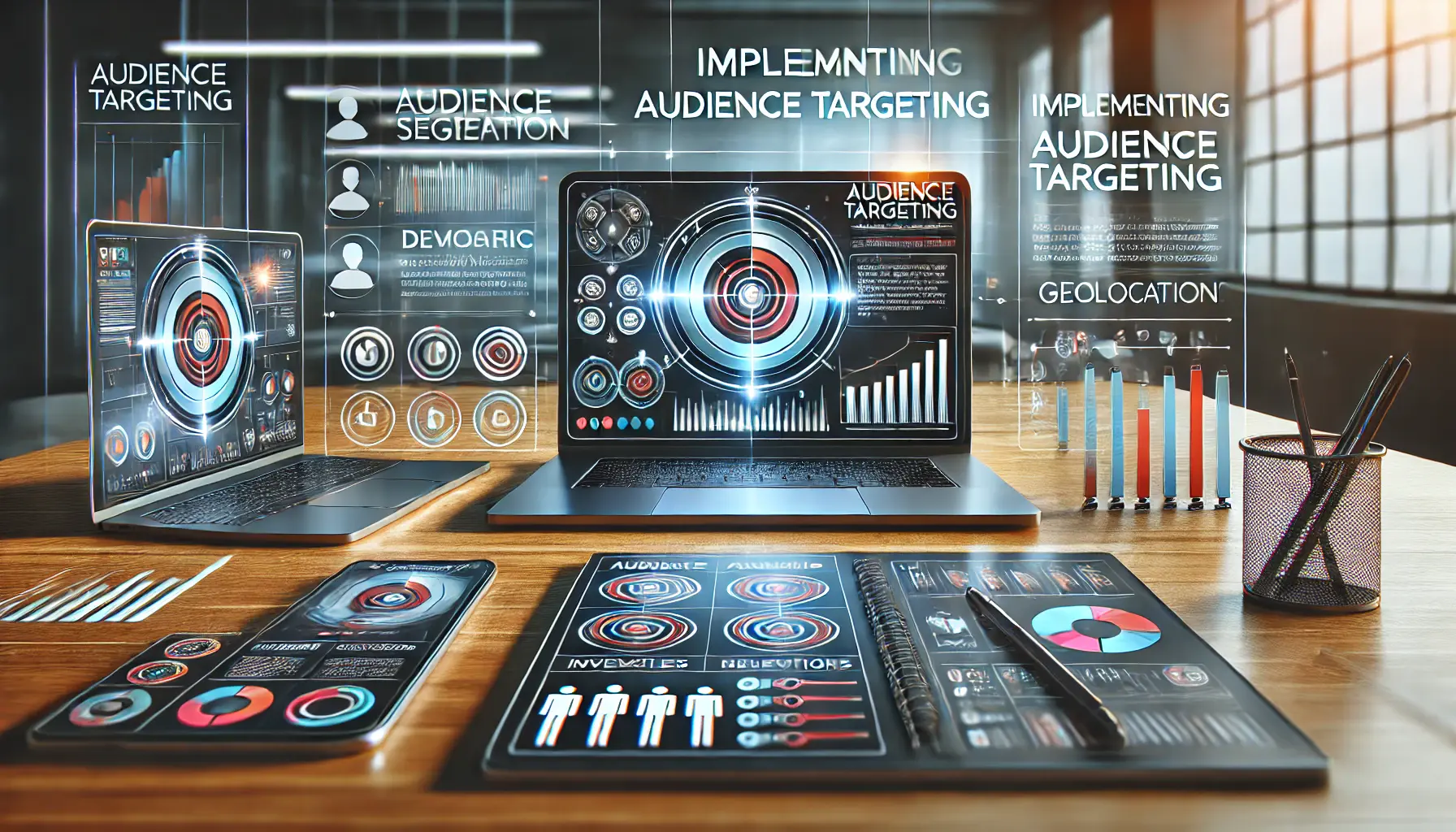
Optimizing digital ad campaigns through precise audience targeting with segmentation and data analysis tools.
Implement Audience Targeting
Defining your target audience is crucial before launching your Google Ads campaign.
This involves identifying the demographics, behaviors, preferences, and other relevant characteristics of your ideal customers.
Understanding your audience allows you to tailor your ad messaging and targeting strategies to resonate effectively, leading to increased relevance and improved ROI.
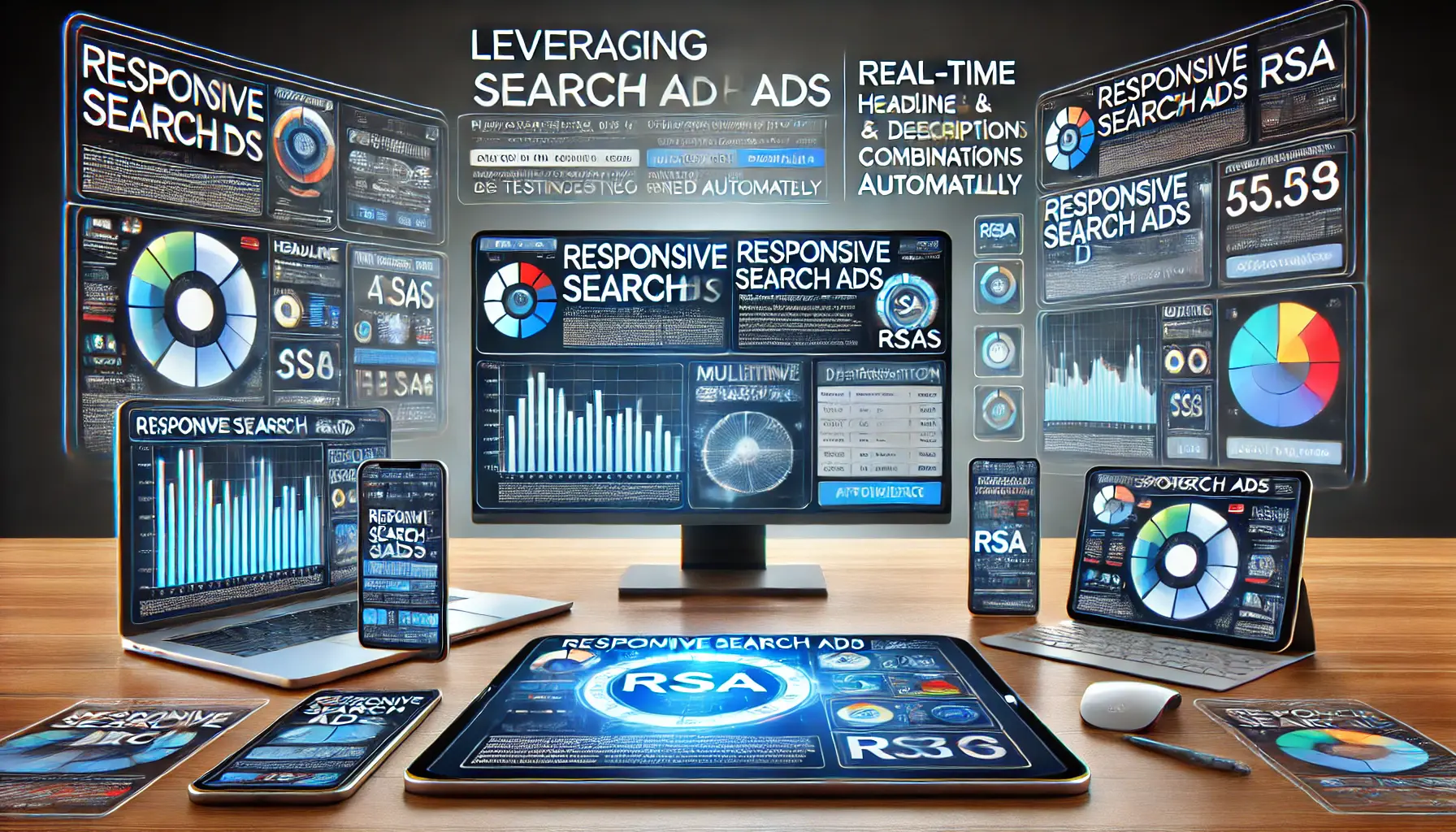
Optimizing Google Ads campaigns with responsive search ads (RSAs) through automated headline and description testing.
Leverage Responsive Search Ads (RSAs)
Responsive Search Ads allow you to create ads with multiple headlines and descriptions.
Google then automatically tests different combinations and serves the most relevant ones to your audience.
By providing up to 15 different headlines and 4 descriptions for each responsive search ad, you can enhance ad relevance and performance, leading to higher click-through rates (CTR) and conversion rates.
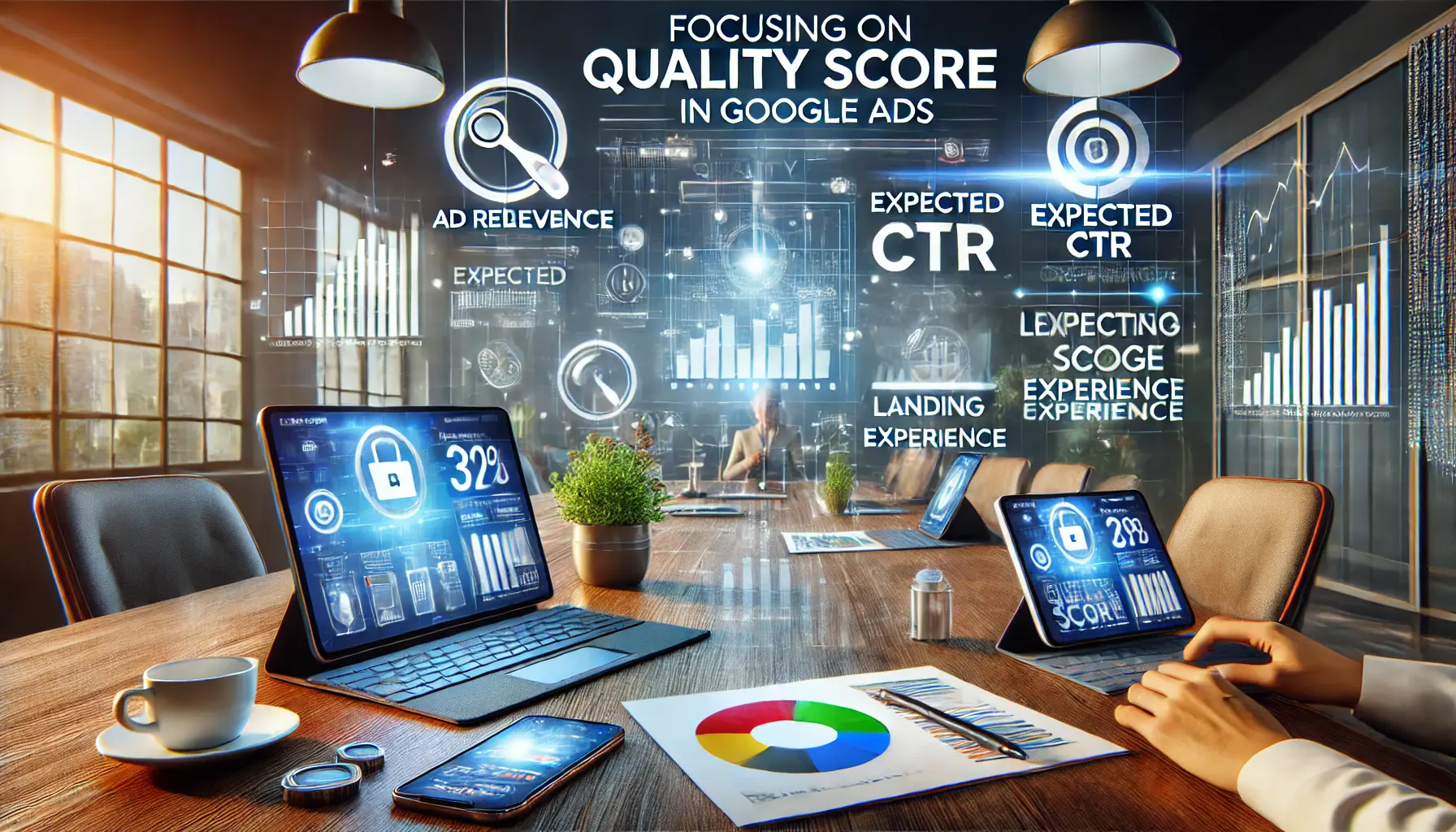
Optimizing Google Ads quality score through ad relevance, CTR, and landing page performance metrics.
Focus on Quality Score
For 2024, Quality Score remains a cornerstone for any Google Ads campaign.
It affects both ad placements and cost-effectiveness.
You improve your Quality Score by improving ad relevance, expected CTR, and landing pageThe web page where users land after clicking on an ad, designed to convert visitors into leads or customers. experience.
By enhancing these factors, you will ensure better ad positions at lower costs.
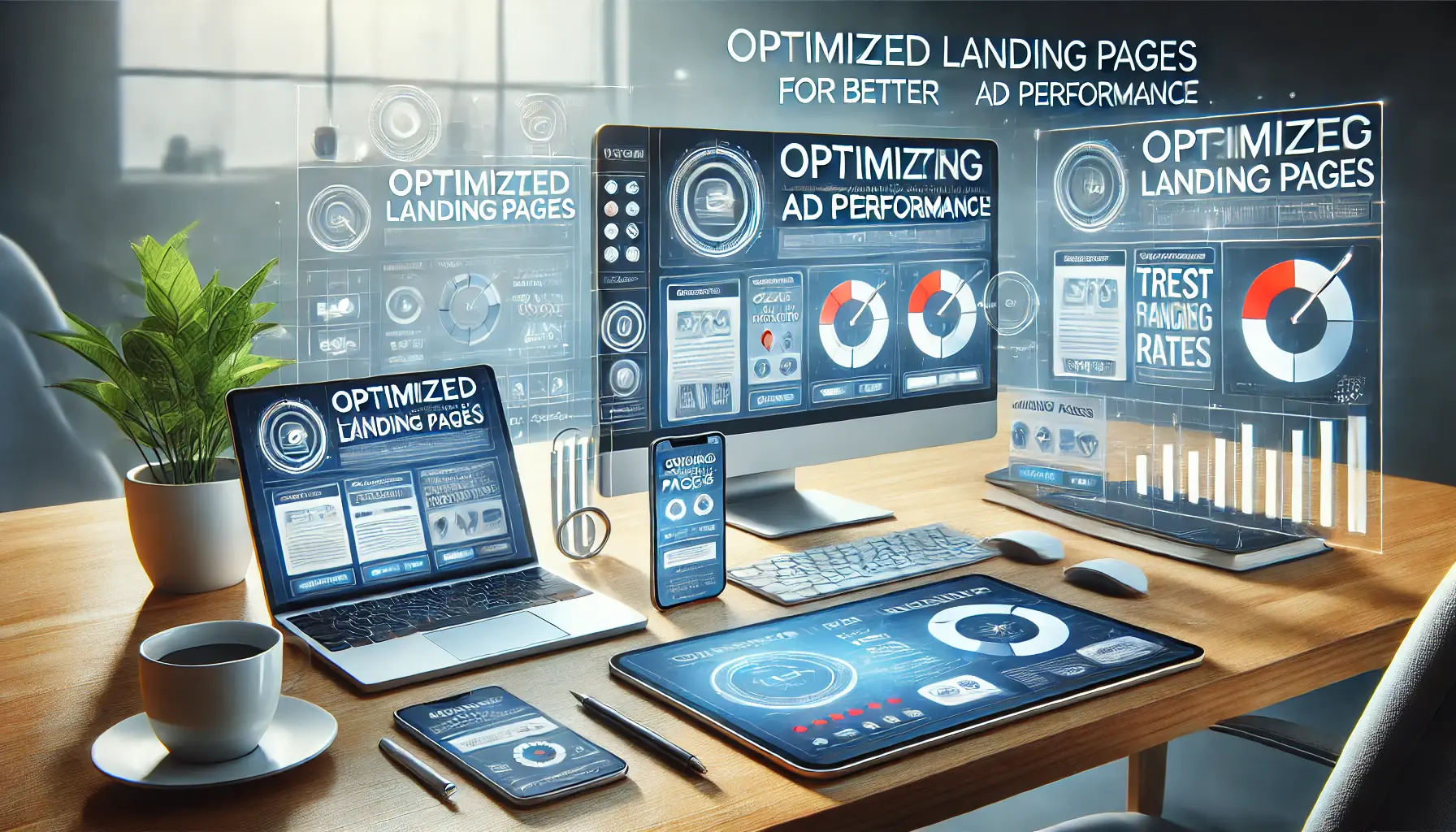
Optimizing landing pages for better ad performance and user experience in digital marketing.
Optimize Your Landing Pages
A well-optimized landing page not only improves user experience but also increases the likelihood of conversions.
Ensuring your landing page content is directly relevant to the ad that brought the user to the page, providing clear calls-to-action (CTAs), and including trust signals such as customer testimonials can significantly enhance conversion rates.

Optimizing Google Ads campaigns with smart bidding strategies, focusing on automated real-time adjustments.
Utilize Smart Bidding Strategies
Google’s Smart BiddingGoogle's automated bidding strategy that uses machine learning to optimize ad performance in real time. algorithms use machine learning to automatically optimize your bids in real time, based on a wide range of signals such as user behavior, location, and device.
By applying Smart Bidding, advertisers can achieve better results with less manual effort and efficiently manage their budgets for improved campaign performance.

Testing different ad formats in digital marketing through a dynamic workspace with multiple devices.
Experiment with Ad Formats
Google Ads offers a variety of ad formats, including text ads, display ads, shopping ads, and video ads.
Experimenting with different ad formats can help you determine which ones resonate best with your target audience, leading to improved engagement and conversion rates.
For instance, setting up Google Shopping campaigns to display your product images and prices directly in search results can target users who are ready to make a purchase.
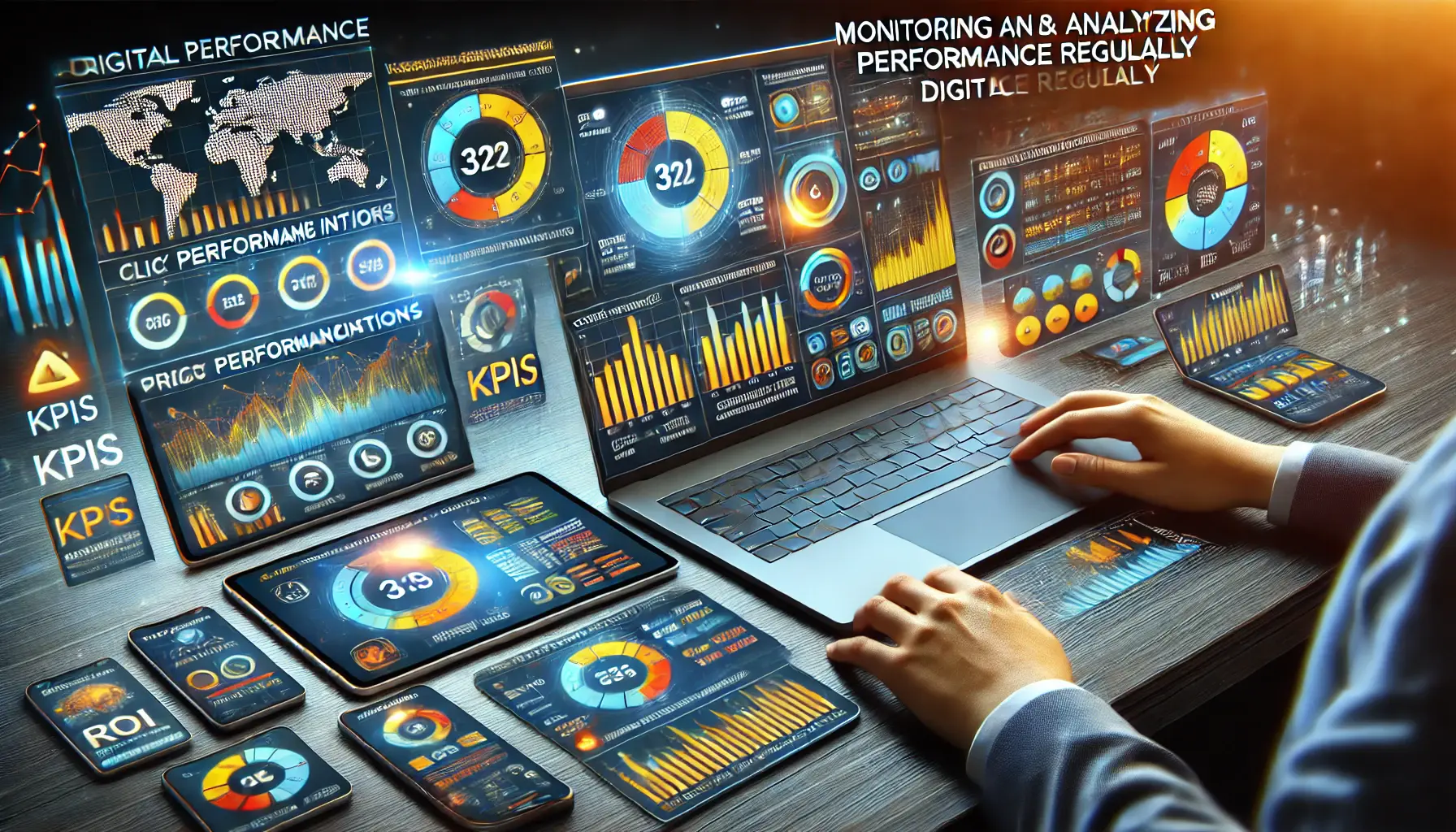
Regularly monitoring and analyzing performance through real-time metrics and data dashboards in digital marketing.
Monitor and Analyze Performance Regularly
Regular monitoring and analysis of your campaign performance are essential to identify areas for improvement.
Utilizing Google Ads’ reporting tools to track key metrics such as CTR, CPC, conversion rate, and ROI can provide valuable insights.
By analyzing this data, you can make informed decisions to optimize your campaigns effectively.
By implementing these strategies, you will be able to further improve your Google Ads campaigns, achieve better performance, and effectively reach your target audiences in 2024.
Key strategies such as mastering keyword research, leveraging responsive ads, and optimizing landing pages can significantly improve campaign ROI.
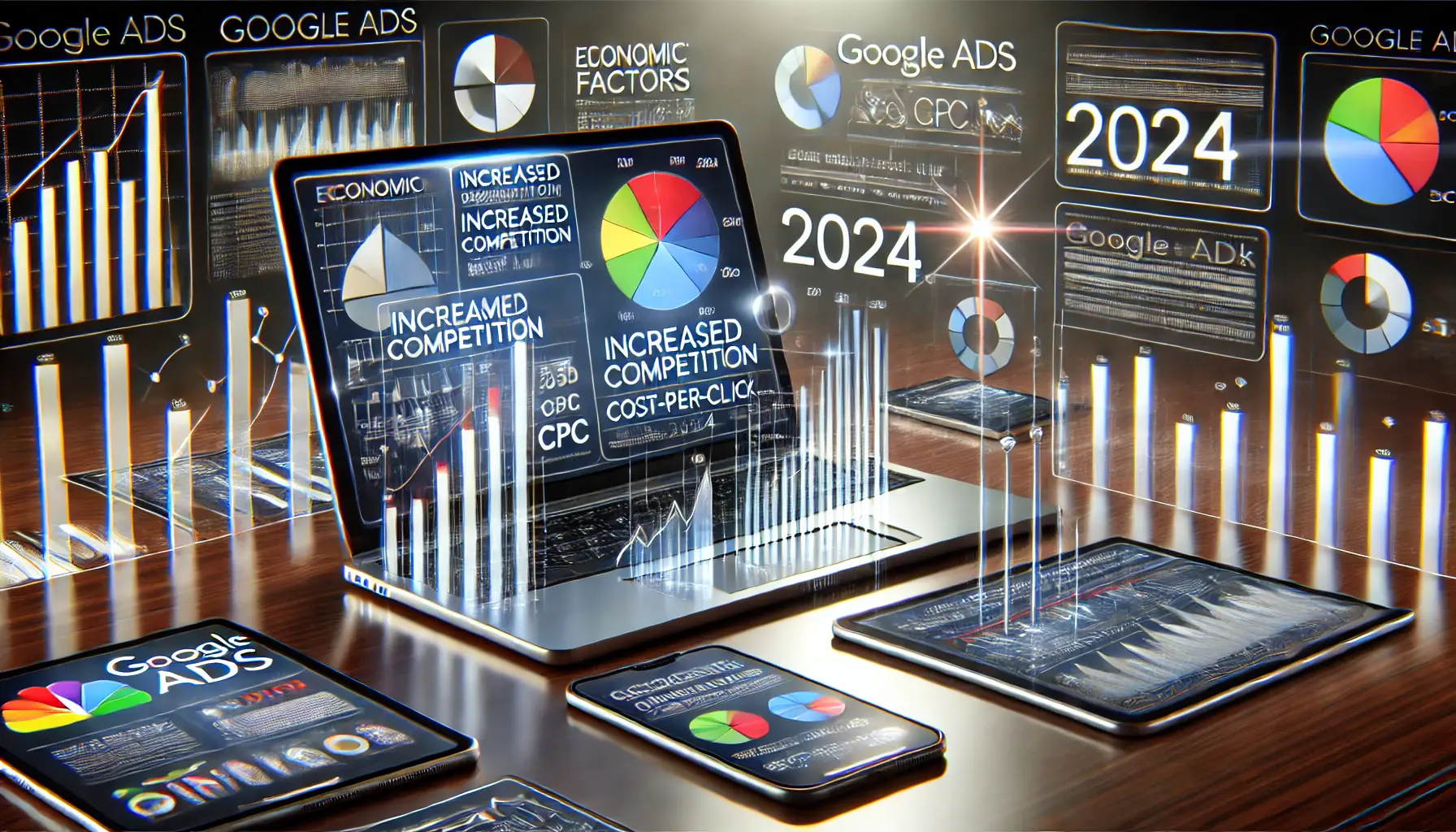
Analyzing the impact of economic factors on Google Ads metrics in 2024, including competition and cost-per-click.
Impact of Economic Factors on Google Ads Metrics in 2024
Understanding how economic factors influence Google Ads metrics is crucial for advertisers aiming to optimize their campaigns effectively.
In 2024, several economic trends have significantly impacted key performance indicators (KPIs) in digital advertising.

Analyzing the impact of increased competition on advertising costs, with dynamic data visualizations.
Increased Competition Leading to Higher Costs
The digital advertising landscape has become increasingly competitive, with more businesses investing in online marketing.
This heightened competition has led to a rise in Cost-Per-Click (CPC) across various industries.
For instance, 86% of industries experienced an increase in CPC, with sectors like Real Estate, Sports & Recreation, and Personal Services seeing increases of over 25% year-over-year, averaging an overall increase of 10%.

Analyzing the effects of economic uncertainty on consumer behavior through data trends and spending patterns.
Economic Uncertainty Affecting Consumer Behavior
Economic fluctuations have influenced consumer spending habits, impacting Conversion Rates (CVR) in Google Ads campaigns.
Industries such as Finance & Insurance and Dentists & Dental Services have experienced notable declines in CVR, underscoring the need for continuous optimization to adapt to changing consumer behaviors.

Optimizing ad spend efficiency through technological advancements like AI-driven tools and automated bidding.
Technological Advancements and Ad Spend Efficiency
Advancements in artificial intelligence (AI) and machine learning have enabled more efficient ad spend through automated bidding strategies and improved targeting.
However, the integration of AI has also led to increased competition, as more businesses leverage these technologies to enhance their advertising efforts, contributing to rising CPCs.

Analyzing shifts in advertising costs across industries, illustrating variations in CPC and CPL.
Shifts in Industry-Specific Advertising Costs
Because of these economic factors, the rise in advertising costs has different impacts on various industries.
For instance, the average Cost Per Lead (CPL) in Google Ads in 2024 is $66.69, while for industries like Animals and Pets, the CPL is $34.81.
These variations emphasize the need for industry-specific strategies in optimizing advertising budgets.
By keeping themselves updated on these economic influencers, advertisers will be able to make strategic adjustments in their Google Ads campaigns for better performance and higher returns on investment in 2024.
Rising competition and economic uncertainty have driven higher CPCs and impacted conversion rates, requiring adaptive strategies.
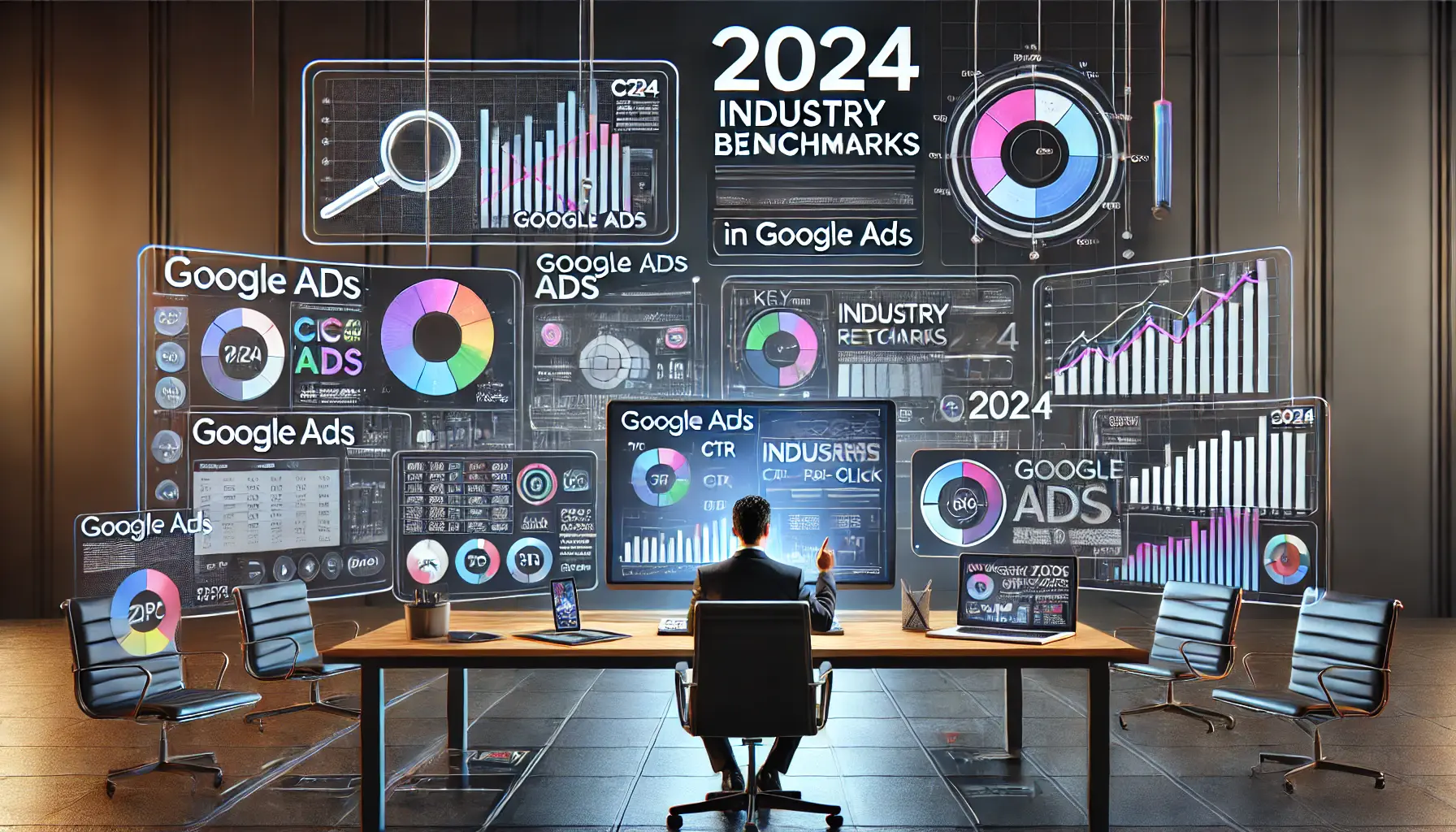
Summarizing 2024 industry benchmarks in Google Ads with key metrics like CTR, CPC, and CVR.
Summary of 2024 Industry Benchmarks in Google Ads
As businesses navigate the evolving digital advertising landscape, understanding industry benchmarks in Google Ads has never been more critical.
In 2024, several key trends, strategies, and economic influences have shaped the performance of Google Ads campaigns, providing valuable insights for advertisers aiming to enhance their campaigns.
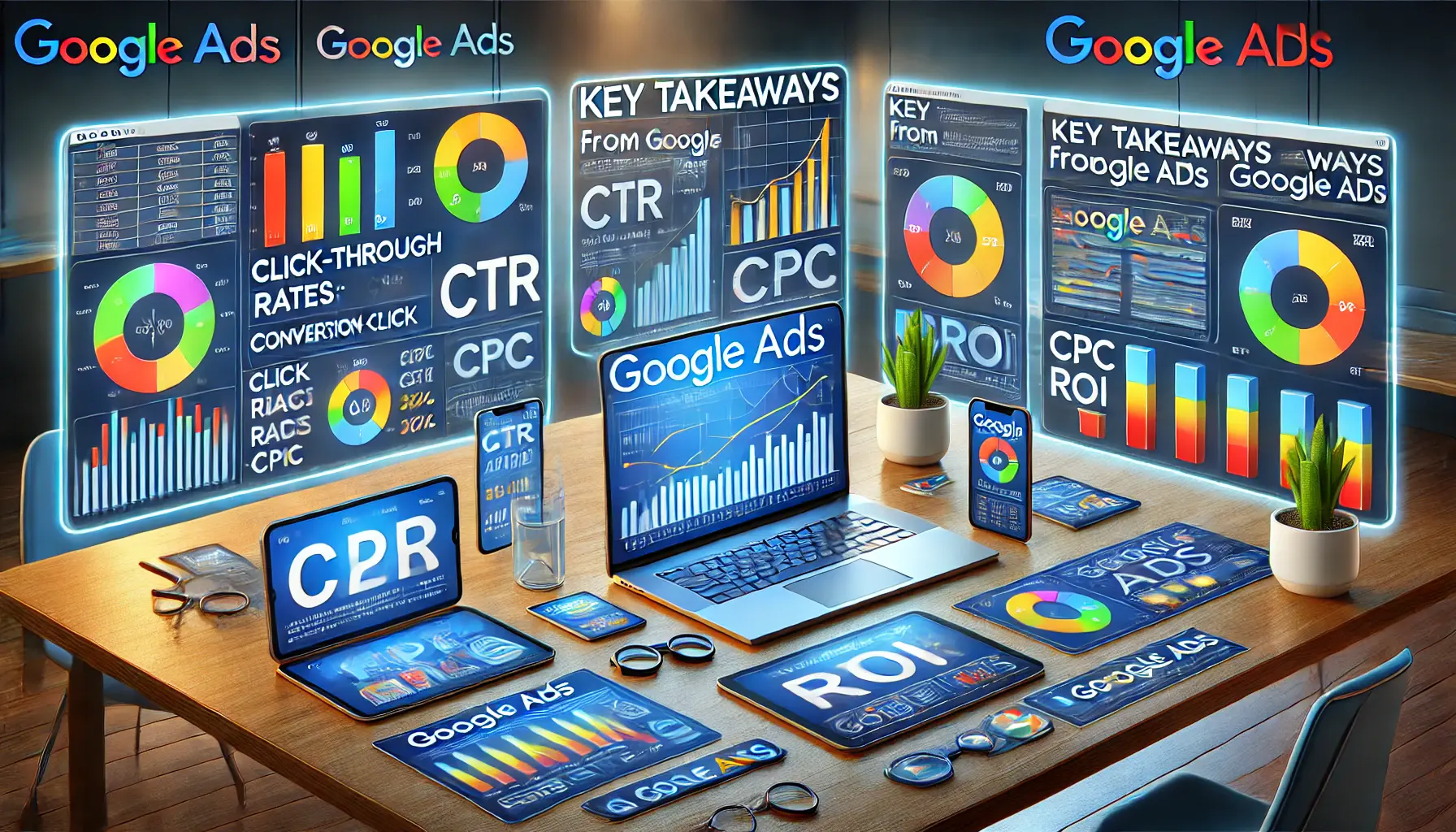
Summarizing key takeaways from Google Ads metrics with graphs and charts showing performance trends.
Key Takeaways from Google Ads Metrics
- Click-Through Rate (CTR): Industries such as Arts and Entertainment and Sports and Recreation showed strong performance in CTR, demonstrating the importance of ad personalization for specific audiences.
- Cost-Per-Click (CPC): Rising CPCs across industries highlight the increasing competition within digital advertising, requiring more focus on budget optimization.
- Conversion Rates (CVR): While some industries experienced declines, others like Apparel and Fashion achieved remarkable improvements, showcasing the effectiveness of well-implemented strategies.
- Cost Per Lead (CPL): Variations in CPL across industries emphasize the need for customized approaches to maximize advertising budgets effectively.
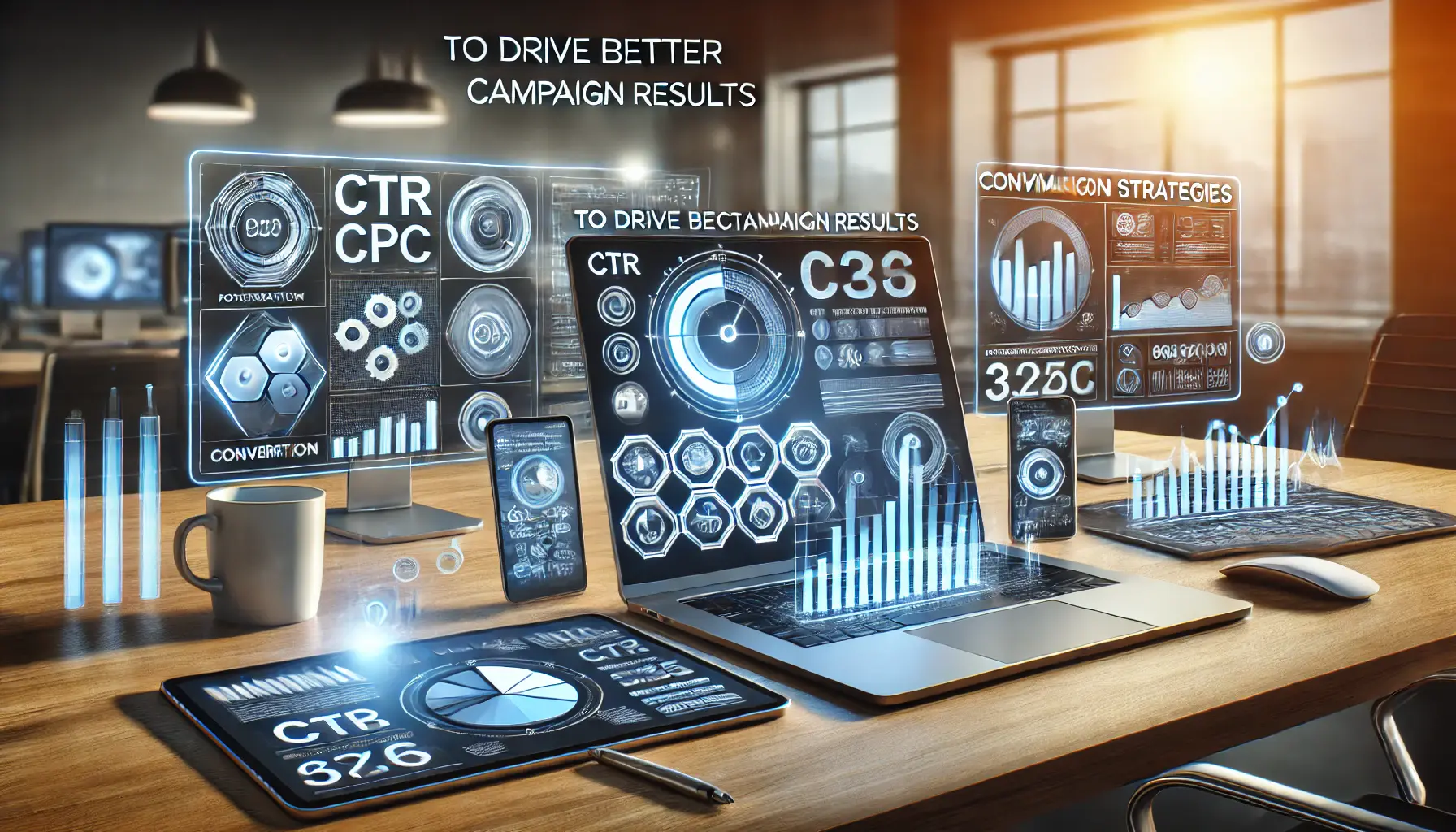
Implementing strategies to optimize digital campaigns with data-driven insights and performance metrics.
Strategies to Drive Better Campaign Results
Advertisers can achieve better results by employing advanced strategies and tools, including:
- Mastering Keyword Research: Understanding user intent and search behaviors to align ads with audience needs.
- Utilizing Responsive Search Ads (RSAs): Enhancing ad relevance through AI-driven testing of headlines and descriptions.
- Optimizing Landing Pages: Creating seamless user experiences to boost conversions.
- Adopting Smart Bidding Strategies: Leveraging machine learning for real-time bid optimization.

Understanding how economic factors such as competition and inflation influence advertising strategies and costs.
Economic Influences on Advertising
Economic trends have driven significant changes in Google Ads metrics in 2024, including:
- Increased Competition: Higher CPCs due to more businesses investing in online advertising.
- Consumer Behavior Shifts: Economic uncertainty influencing spending patterns and conversion rates.
- Technological Advancements: Artificial intelligence and machine learning improving processes while increasing competition.

Concluding thoughts in digital marketing with an organized workspace displaying data analysis and insights.
Final Thoughts
Staying informed about these benchmarks, utilizing effective strategies, and adapting to economic changes are key to achieving optimal performance in Google Ads campaigns in 2024.
Leveraging advanced AI tools, refining targeting tactics, and analyzing key performance metrics will ensure better campaign outcomes and higher ROI.
Applying these insights not only helps businesses remain competitive but also unlocks new opportunities for growth in the ever-changing digital advertising landscape.
2024 benchmarks offer valuable insights for tailoring Google Ads strategies, ensuring competitive campaign performance and cost-efficiency.

Understanding key Google Ads benchmarks through frequently asked questions, with performance metrics and data analysis.
Your campaigns can be managed by an agency specialized in Google Ads, check out our service page.
2024 Industry Benchmarks in Google Ads: Frequently Asked Questions
As we go through the constantly changing landscape of Google Ads in 2024, there are so many questions about industry benchmarks and best practices.
Here are some of the most frequent questions and answers to provide clarity and guidance in this dynamic advertising space.
The average CTR across all industries in 2024 is approximately 6.42%, though this varies by sector.
Industries like Attorneys & Legal Services and Dentists & Dental Services face higher CPCs, averaging $9.21 and $6.69, respectively.
Conversion rates have dropped notably across 91% of industries, averaging a 10% decrease.
The average cost per lead in Google Ads in 2024 is $66.69, with huge differences among industries.
Strategies include perfecting keyword research, leveraging responsive search adsA Google Ads format that allows advertisers to provide multiple headlines and descriptions, which are dynamically combined to show the best-performing version., and optimizing landing pages.
Increased competition has led to a rise in CPC, with an average overall increase of 10% across industries.
Industries such as Arts & Entertainment and Sports & Recreation have experienced notable CTR improvements.
Economic fluctuations influence consumer spending habits, impacting conversion rates in various industries.
Google launched AI-powered campaigns, improved Performance Max campaigns, and new ad formats such as Demand Gen campaigns.







